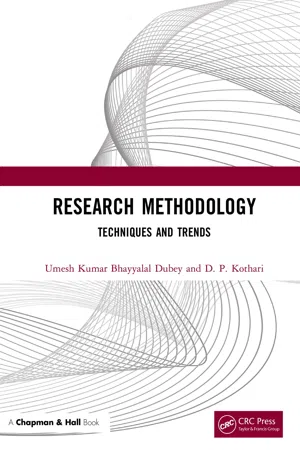Psychology
Sampling Psychology
Sampling in psychology refers to the process of selecting a subset of individuals from a larger population to participate in a research study. The goal is to ensure that the sample is representative of the population, allowing researchers to make generalizations about the larger group. Various sampling methods, such as random sampling, stratified sampling, and convenience sampling, are used to achieve this.
Written by Perlego with AI-assistance
Related key terms
11 Key excerpts on "Sampling Psychology"
- eBook - ePub
Research Methods in Applied Settings
An Integrated Approach to Design and Analysis, Third Edition
- Jeffrey A. Gliner, George A. Morgan, Nancy L. Leech(Authors)
- 2016(Publication Date)
- Routledge(Publisher)
9 Sampling and Introduction to External Validity
DOI: 10.4324/9781315723082-9What Is Sampling?
Sampling is the process of selecting part of a larger group of participants with the intent of generalizing from the sample (the smaller group) to the population (the larger group). To make valid inferences about the population, we must select the sample so that it is representative of the total population.Sample General term for the selected part of a larger group of potential participants taken with the intent of generalizing from the smaller group or sample to the theoretical population.Population The larger group of interest for the study and from which the sample is drawn.Political pollsters and market researchers have developed and refined the process of sampling so that they are usually able to estimate quite accurately the voting or purchasing intentions of the population of the United States from samples as small as several hundred participants. We are all familiar with public opinion and voting surveys, usually done by telephone interviewers who may use random-digit dialing techniques to select the persons whom they choose to call. If the questions are clear and the participants answer them truthfully and accurately, a random sample of approximately 1,000 participants is enough to predict, within ±3 percent, what the whole population of the United States would say or feel about a certain issue.You may be familiar with the Nielsen television ratings, which are based on information gathered about the TV viewing of a few thousand representative households. These ratings are then extrapolated to indicate the percentage of the total TV viewing population of the United States that would have watched a certain show, and this determines advertising rates. A similar Nielsen system was developed to assess the specific shopping behaviors of a sample of American consumers who actually scanned the bar codes on the items they purchased so that Nielsen could report information to manufacturers not only about the number and types of items purchased but, perhaps more importantly, also about profiles of the people who were doing the buying. - eBook - ePub
Dissertation Research Methods
A Step-by-Step Guide to Writing Up Your Research in the Social Sciences
- Philip Adu, D. Anthony Miles(Authors)
- 2023(Publication Date)
- Routledge(Publisher)
Figure 16.1 illustrates the major steps in the sampling process.Source: Adopted from Sekaran and Bougie (2013).Figure 16.1The sampling process.Before choosing a specific type of sampling technique, a broad sampling technique needs to be decided on. One of the difficult aspects of research is launching an experience-sampling study. It can provide a challenge to even the most seasoned researcher (Christensen et al., 2003 ). When a researcher decides to begin the research process, they must go through the sampling process first. The first stage in the sampling process is to clearly define the problem. Defining the problem is the basis for all research. This also relates to determining the sampling frame. The sampling frame must be representative of the population of interest. This is vital to the research.The next step is to determine the sample design. Establishing the sample design is very important to the researcher. The next step is to determine the appropriate sample size for the study. We have to remember that the population is commonly related to the number of people living in a particular area of the country. Lastly, the researcher has to execute the sampling process. Again, sampling can be used to make inferences about a population.Types of Sampling
The practice of sampling can be used to make an inference about a population or to make a generalization in relation to an existing theory. This is based on the choice of sampling technique.The practice of evaluating the characteristics of an entire population through a representative sample can be an arduous endeavor. As with many research studies, the best strategy to investigate a problem in an entire population is through the use of sampling. How, it is not always possible to conduct a study on an entire population. So, we use the practice of sampling. Thus, the researcher studies a sample of the population, which is a suitable representation of the entire population. We must think of a sample as a subset of the population; thus it is selected to be representative of the population. Again, one of the advantages of sampling is that it can be less costly and more efficient. Being able to use a sample to generalize the results to a whole population requires the use of one of the statistical sampling methods for evaluation. Taking a subset from a chosen sampling frame or entire population is the basic practice of sampling. - No longer available |Learn more
- Levent Altinay, Alexandros Paraskevas, SooCheong (Shawn) Jang(Authors)
- 2015(Publication Date)
- Routledge(Publisher)
5 SamplingPeople are pretty much alike. It’s only that our differences are more susceptible to definition than our similarities. (Linda Ellerbee, Broadcast Journalist, 1944–)When undertaking any research, it is essential that you obtain data from people who are as representative as possible of the group you are studying. Even with the perfect questionnaire or interview guide (if such a thing exists), your data will only be regarded useful when your respondents are representative of the population as a whole. For this reason, a clear understanding of the principles of sampling is essential in order to conduct any type of research, whether quantitative or qualitative. Imagine a researcher investigating how tourism policies are developed for a destination or a country. This researcher obviously needs expert opinion, and most probably the views of those who develop policies. Even if the researcher develops an excellent questionnaire or interview guide, appropriate responses will not be acquired if the people interviewed are local people and/or visiting tourists. These respondents will probably not have any idea about how policies are developed.What is sampling?
Sampling is the process by which researchers select a representative subset or part of the total population that can be studied for their topic so that they will be able to draw conclusions regarding the entire population. These conclusions and any generalizations the researcher makes are only as good as the sample they are based on. The obvious advantage of sampling is that the smaller number of elements (e.g. people, organizations) to be studied makes the research more manageable and time-efficient, less costly, and potentially more accurate (since it is more feasible to maintain control over a smaller number of elements). For example, if your research looks at how consumers in the People’s Republic of China make their travel decisions, it is clearly impossible to send 1.3 billion questionnaires in order to cover the entire population. You will need to select a sample of people that is, as far as possible, representative of the entire population of China. This, of course, is quite a challenge. All samples deviate from the true nature of the overall population by a certain amount, owing to chance variations in the selection of the sample’s few elements from the population’s many possible elements. This is called sampling error, and can be reduced by selecting a large sample and by using efficient sampling design. - eBook - ePub
- Judy L. Krysik(Author)
- 2018(Publication Date)
- Routledge(Publisher)
Important choices in the formulation of a sampling plan include what to study and whether to collect data from the whole population or to limit data collection to a sample. A population is the totality of persons, events, organizational units, and so on that the research problem is focused on. A sample, in contrast, is a subset of the population. As one example, if a researcher conducted a study of students at your school, the population would consist of the entire student body. Any subset of that population—for example, 100 students picked at random—would represent a sample. In instances when sampling is the preferred approach, researchers must decide how to select the elements they wish to study. In sampling, the term element refers to each member or entity in the population. Another question that the sampling plan must address is “How big should the sample be?” Finally, the plan must indicate whether the sampling method will permit inferences. By making an inference, the social work researcher is claiming that what holds for the sample is likely true for the population from which the sample was drawn. In the example just cited, the researcher would assume that the results of the study of 100 students could be generalized to the entire student population. Exhibit 8.1 outlines the steps that the researcher will address in the formulation of a sampling plan - No longer available |Learn more
- John D. DeLamater, Jessica L. Collett(Authors)
- 2018(Publication Date)
- Routledge(Publisher)
It would be virtually impossible—and enormously expensive—to interview all people in the population of White adults, so the researcher instead selects a sample, or representative subset, from that population to interview. Sample selection is one of the most important aspects of any type of survey. In some cases, investigators may use a particular sample simply because it is readily available; samples of this type are known as convenience samples. A sample consisting of students taking a class, occasionally used in social science research, is a convenience sample. Convenience samples have a major drawback—they usually lack external validity and do not enable the investigator to generalize the findings to any larger population. For this reason, it is better research practice to select some other type of sample—one that is representative of the underlying population. Only when the sample is representative can the results obtained from it (for example, information regarding racial prejudice obtained from survey respondents) be generalized to the entire population. The nature of the sample, therefore, has a major impact on the external validity of the survey. Two types of systematic samples are commonly used in social psychological surveys. One is the simple random sample, wherein the researcher selects units—usually individuals—from the population such that every unit has an equal probability of being included. To use this technique, the researcher needs a complete list of members of the population. At a university, for example, they might obtain a list of all students from the registrar. At the city or county level, they might use voter registration lists. A frequent problem, especially when the population being studied is large, is the absence of a complete list. Under these circumstances, researchers usually fall back on some substitute, such as a telephone directory - eBook - ePub
Research Methodology
Techniques and Trends
- Umesh Kumar B Dubey, D P Kothari(Authors)
- 2022(Publication Date)
- Chapman and Hall/CRC(Publisher)
6 Sampling DesignDOI: 10.1201/9781315167138-66.1 Introduction to Sampling
Where it is not possible to study the entire population, in such situations researchers use the concept of sampling. For a variety of reasons, researchers usually cannot make direct observations of every unit of the population they are studying. Instead, they collect data from a subset of population called as a sample and use these observations drawn to make inferences about the entire population.Ideally, the characteristics of a sample should correspond to the characteristics of a population from which the sample was drawn. In that case, the conclusions drawn from a sample are probably applicable to the entire population.Sampling is the backbone of marketing research. In this chapter, you will be introduced to various sampling concepts. A brief mention of sampling and nonsampling errors will be made. The various probability and nonprobability sampling designs as applicable to marketing research will be introduced. Since the choice of sample size involves various elements such as time, money accuracy, etc., an important decision while taking a sample is to know how large a sample should be taken. Therefore, the determination of sample size would also be discussed.6.2 Basic Definitions and Concepts
Researchers usually cannot make direct observation of every individual in the population under study. Instead, they collect data from a subset of individuals called as a sample and to make inferences about the entire population using those observations.6.2.1 Element
The unit about which information is collected is called as an element. According to a well-defined procedure this provides the basis for analysis. Elements should be well defined and the possibility of identifying them physically is important. For example, in a retail stores survey, a shop may be considered as a unit, whereas in a family budget enquiry a household may be treated as a unit. - eBook - ePub
- Paul Richardson, Allen Goodwin, Emma Vine(Authors)
- 2011(Publication Date)
- Learning Matters(Publisher)
Random sampling is when all individuals within a population have the same chance of being included in the research as a participant. With a sufficient sample size, a random sample has the most likelihood of reflecting the range of data as found in the population as a whole. Although this method is preferable to other methods of sampling, it is often the most expensive and not possible due to financial constraints. A common mistake is to confuse random sampling with random allocation. Random allocation is where the participants are allocated to one or more conditions randomly in order to minimise the effect that individual differences may have upon the research outcome. It is more likely that some sort of quota convenience sampling or opportunistic sampling will be used. This is where participants are recruited as conveniently as possible (for example, through poster advertisements, direct contact or the internet etc.) and a specified number has been set by the researcher. Although problems may arise with this method, it is one of the most practical and efficient methods of quickly recruiting participants. However, with this method greater care must be taken to avoid unrepresentative placement of participants across the different conditions. It may even be worth considering exclusion criteria. For example, should psychology students be allowed to take part in psychology-based research? Does their possible knowledge of certain areas automatically preclude them from taking part? Whatever the sampling method, we infer that the results and findings obtained from our recruited cohort apply to the population as a whole. Therefore, if there is an inherent flaw in our recruitment of participants, then our results cannot be inferred on methodological grounds to be generalisable to the population as a whole. Task Researchers wished to test the effect of a new learning strategy on high-speed learning - eBook - ePub
Counseling Research
A Practitioner-Scholar Approach
- Richard S. Balkin, David M. Kleist(Authors)
- 2016(Publication Date)
- American Counseling Association(Publisher)
Systematic random sampling uses a combination of cluster sampling and simple random sampling. In systematic sampling, potential participants from the accessible population are placed into groups. For example, 30 individuals are listed in each of 40 groups. The researcher randomly selects a number from 1 to 30 (e.g., 13), and the 13th member of each of the 40 groups is selected to participate.Nonprobability sampling, also referred to as convenience sampling, is a process of recruiting and selecting participants for research who are accessible to the researcher. Nonprobability sampling represents the most common type of sampling in counseling research. However, a consequence of using nonprobability sampling is that the generalizability of the research findings is extremely limited. Social science research, as a general rule, is overrepresented by college student participants. Do findings based on college students really generalize to an adult population? Arguments for how college students are developmentally different from the overall population are quite salient. Furthermore, researchers who use college students as participants might be limited by type of college or geographic region. A final thought is that research conducted with actual clients in a variety of settings is not random, but such research on client outcomes and the efficacy of counseling is essential to moving the counseling profession forward. Most research in counseling depends on the use of convenience sampling, and counseling researchers need to be able to identify the appropriateness of a sample, particularly when nonprobability sampling is utilized. Let's take a look at how this is done.The Representative Sample Versus the Random Sample
You have had a brief review of random sampling, so let's talk about why random sampling may be impractical in counseling research and perhaps in most social science research.Although we would hesitate to say that all - eBook - ePub
Researching Health Needs
A Community-Based Approach
- Judy Payne(Author)
- 1999(Publication Date)
- SAGE Publications Ltd(Publisher)
Chapter 9 .The key requirement of your sample is that it is representative of the population. This means that the various groups and types of person in the community are included in the sample to the same extent as they are in the population. You will also have to allow for how varied your population is in relation to the information you want (for example, in terms of age, gender, occupation, etc.). If the people are very different, you have to try to ensure that you will include representatives of all the various types by selecting a larger sample or by using some method of selecting from each of the groups (stratified sampling). However, the total number of people that you select will be mainly determined by your resources.If you do not have or cannot compile a list of your population, you can use a non-probability sampling method – quota sampling, snowballing and purposive sampling. Here the researcher or the respondent or both influence the selection process. Because this process is not statistically random, it is not possible to assess, with any confidence how good a representation your sample is of your population. In exploratory and qualitative studies, this may not be important. However, non-random selection does limit the generalizability of the claims you may make for your results. Non-probability sampling methods are discussed later in this chapter.Simple random sampling
If you have a suitable population list in which everyone has an equal chance of being selected – one that is not ordered in any way and does not contain duplicates – then you can draw a simple random sample. The most common methods of selection are by lottery, by using random numbers and by systematic sampling. In all of them you will need to know the size of your population and of your sample, and your list must be numbered. This list is referred to as a sampling frame - eBook - ePub
Quantitative Research Methods in Communication
The Power of Numbers for Social Justice
- Erica Scharrer, Srividya Ramasubramanian(Authors)
- 2021(Publication Date)
- Routledge(Publisher)
And when particular sampling procedures are followed, the idea of giving voice is amplified beyond those directly studied into larger populations, a unique strength of quantitative research for social justice. Sampling is the process of “deciding what to observe and what not to observe” (Babbie, 2010, p. 189). It sounds so straightforward, and in many ways it is. But, just like with any researcher-originated decision, there are a number of key considerations and important implications when deciding how to draw a research sample. Thankfully, as we have seen with the process of operationalization, there are widely accepted guidelines, principles, and approaches, many of which are established through applying the principles of the scientific method. In this chapter, we will introduce those guidelines, principles, and approaches as well as consider the social justice implications of each. The question of who or what will comprise the research sample is vitally important in quantitative social science research. In fact, it is one of the central elements of what we have called “the power of numbers.” One of the chief strengths of quantitative research is its ability to explore patterns that are determined to be widely shared—or, conversely, are shown to be relatively rare—within a large and potentially heterogeneous group. As we saw in Chapter 1, qualitative research typically uses small samples and is not always concerned about generalizing findings to a larger population. Qualitative research, therefore, can tell us a whole lot about a relatively small body of people or of texts. But those observations may well be quite unique to that small group, and therefore their applicability to a broader body can be limited. In quantitative research, we draw somewhat less detailed observations from a larger body of people or of texts. In doing so, we strive to say something more widespread and more general about the phenomenon we are studying - eBook - ePub
Statistics: An Introduction: Teach Yourself
The Easy Way to Learn Stats
- Alan Graham(Author)
- 2017(Publication Date)
- Teach Yourself(Publisher)
N, is known as a ‘census’.Random samplingThe tale of Keith Parchment illustrates two very important features of sampling. First, if a sample is too small it may not provide a very reliable or representative cross-section of the population as a whole and indeed may give a wrong impression of it. Second, there is the other side to this coin, namely that large samples, although they may be highly representative and accurately reflect the population, are usually also very expensive and time-consuming to carry out. In practical terms, therefore, sampling is always a compromise between accuracy on the one hand and cost on the other.A random sample is one in which every item in the population is equally likely to be chosen.There are several techniques for choosing a representative sample, of which probably the best known is random sampling. Its basic definition is as follows.With random sampling, there also needs to be some sort of random-generating process used to select each item. Suppose, for example, we wished to select a sample of size 50 (sample size, n = 50) from a population consisting of a sampling frame of size 1000 (i.e. N = 1000). The usual approach would be to allocate a number to each item in the sampling frame (from 1 to 1000 or perhaps from 0 to 999) and then find some way of randomly generating 50 numbers from within this range. The population items which had been allocated these numbers then become the 50 items which form our sample.There are two common methods of random sampling – sampling with replacement and without replacement. Replacement means simply putting an item back into the sampling frame after it has been selected. Although replacement is sometimes thought of as being a more correct form of random sampling, in most practical sampling situations items are not replaced after they have been selected.
Index pages curate the most relevant extracts from our library of academic textbooks. They’ve been created using an in-house natural language model (NLM), each adding context and meaning to key research topics.










